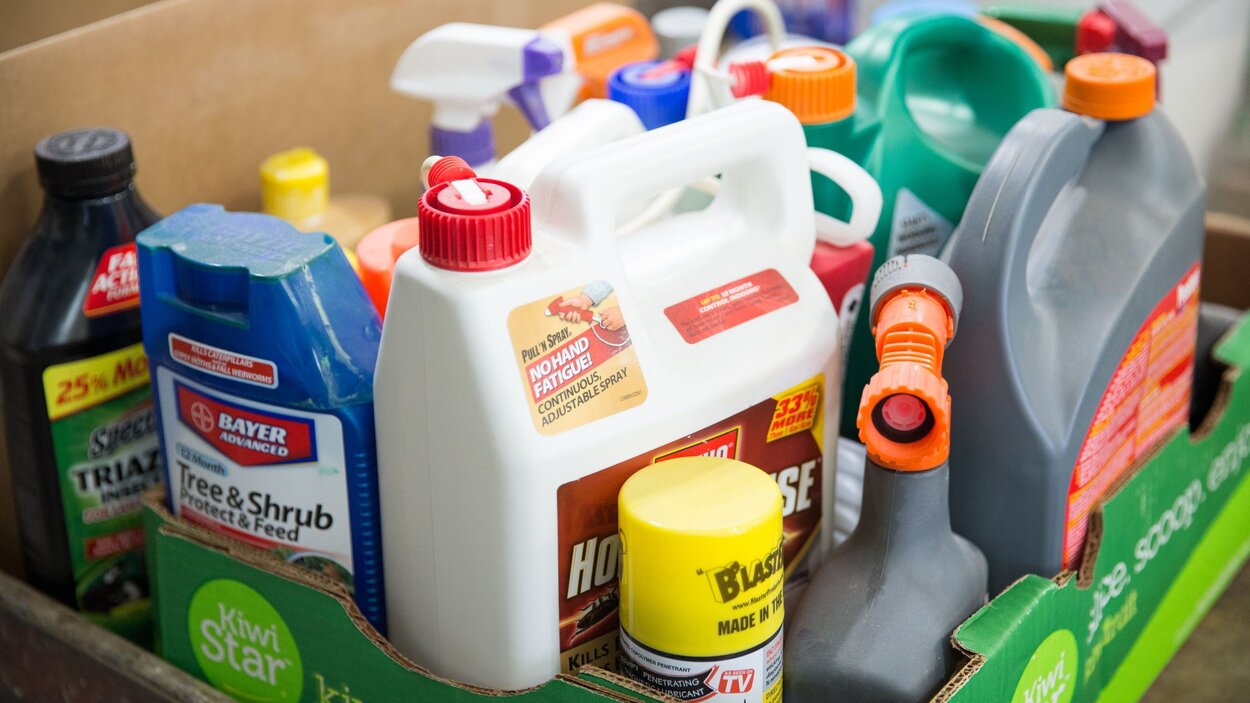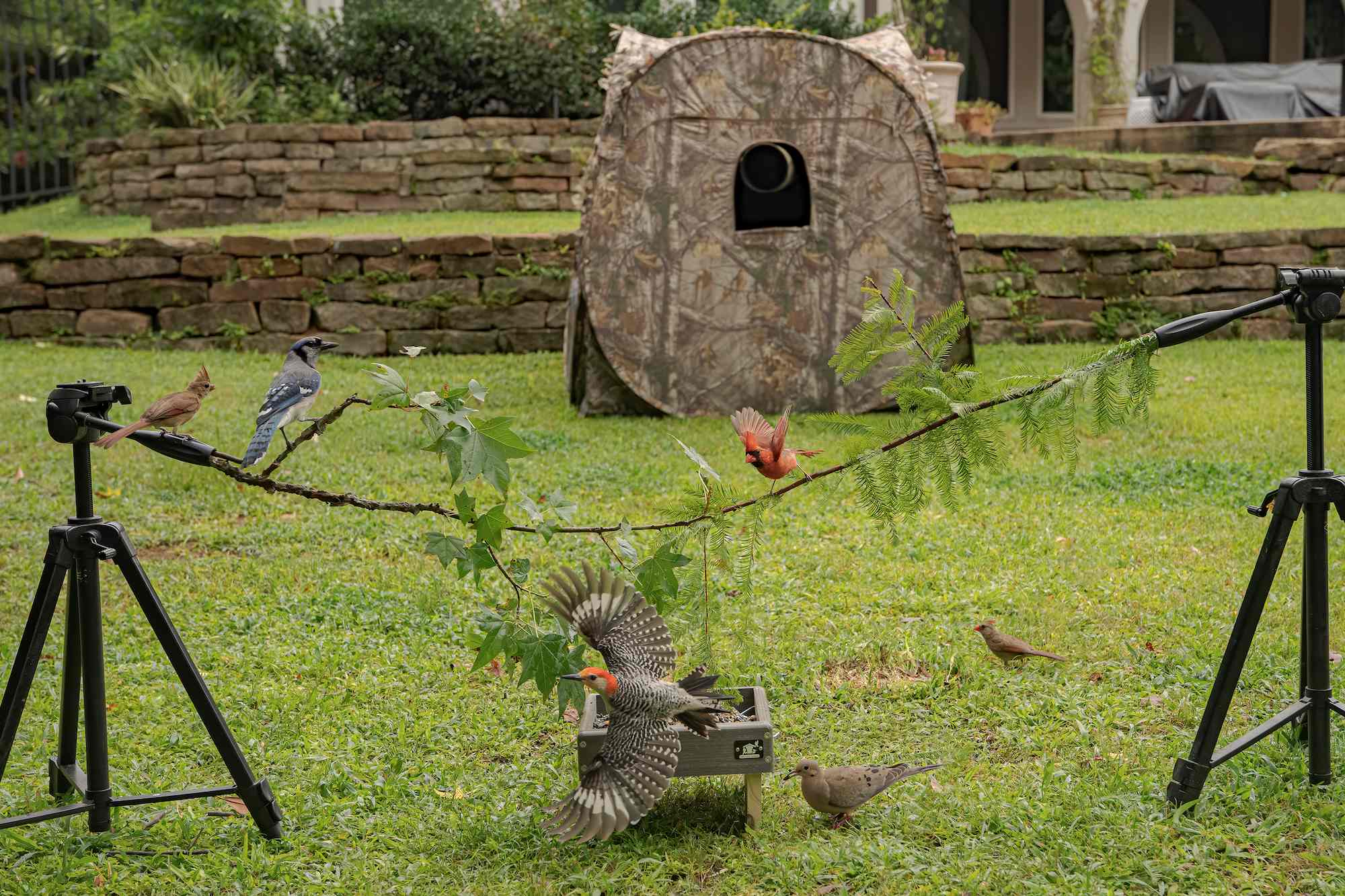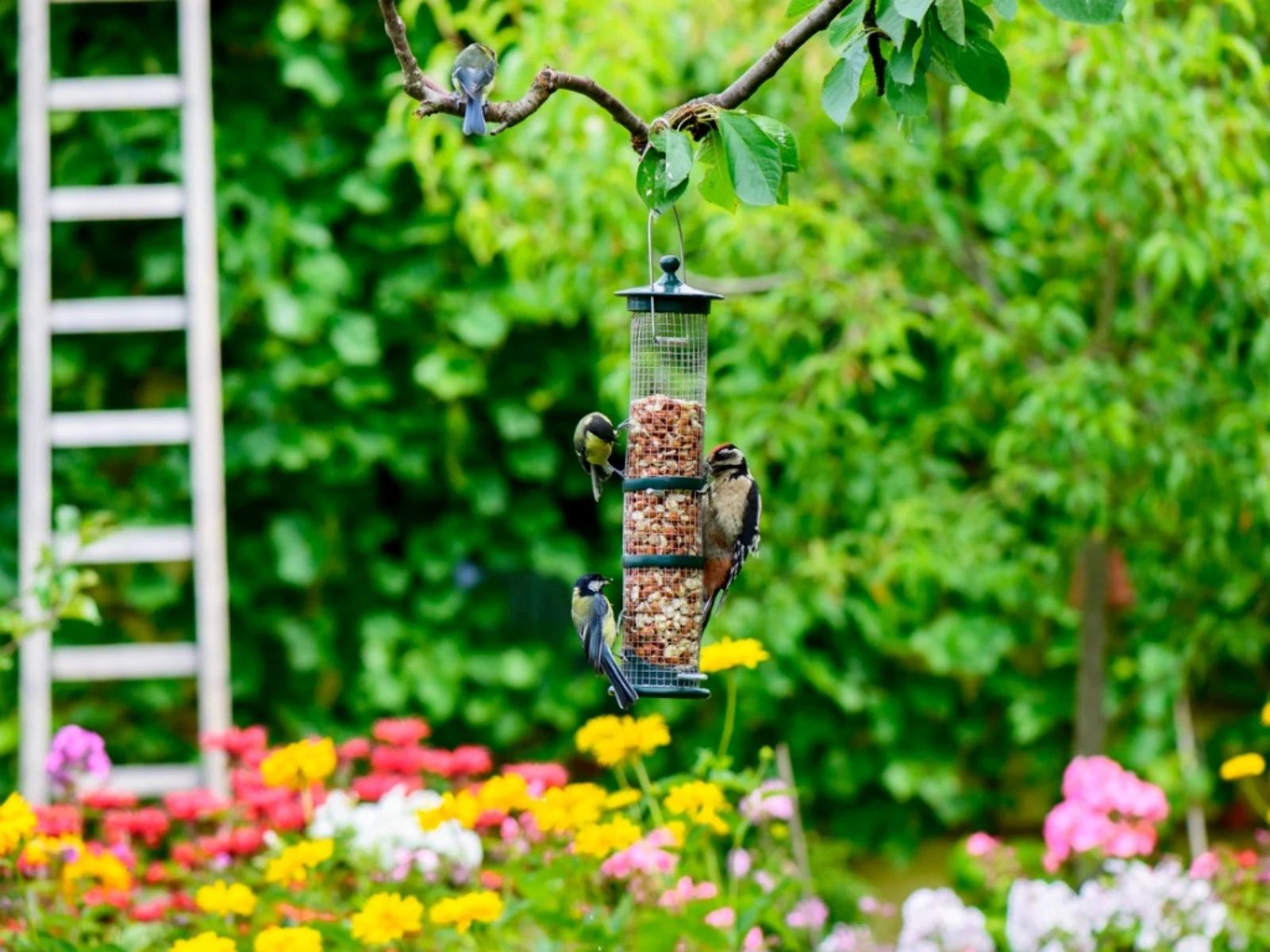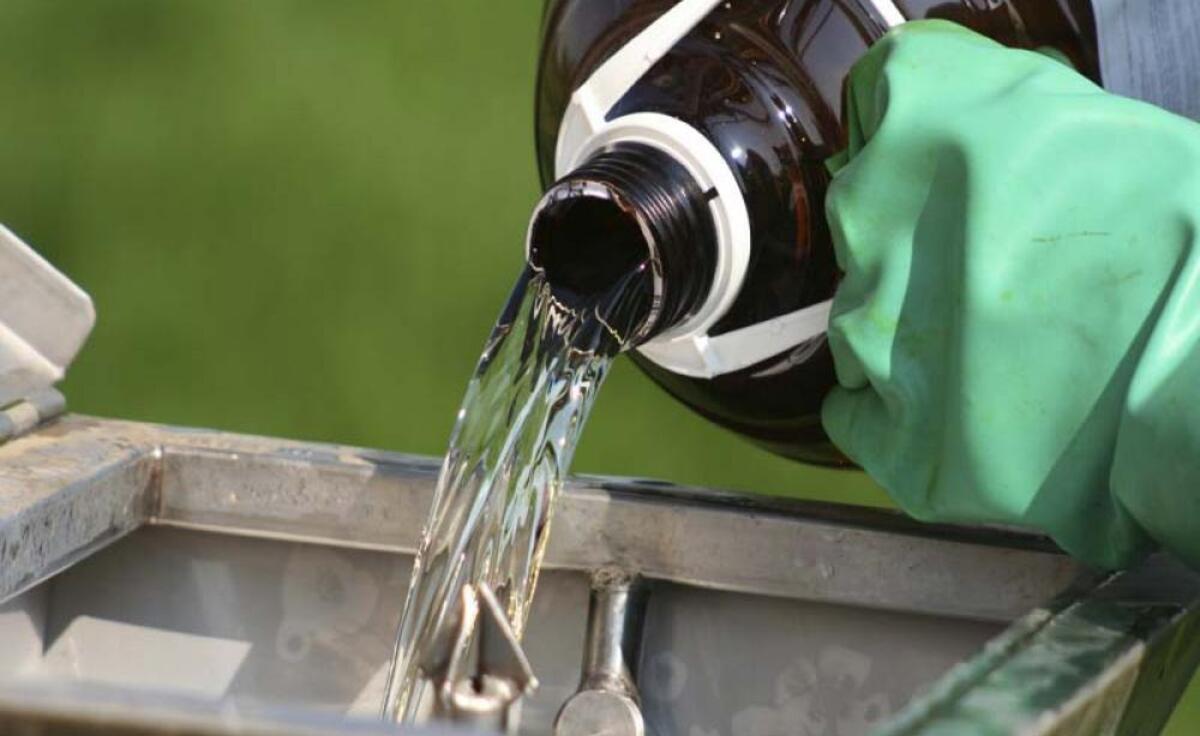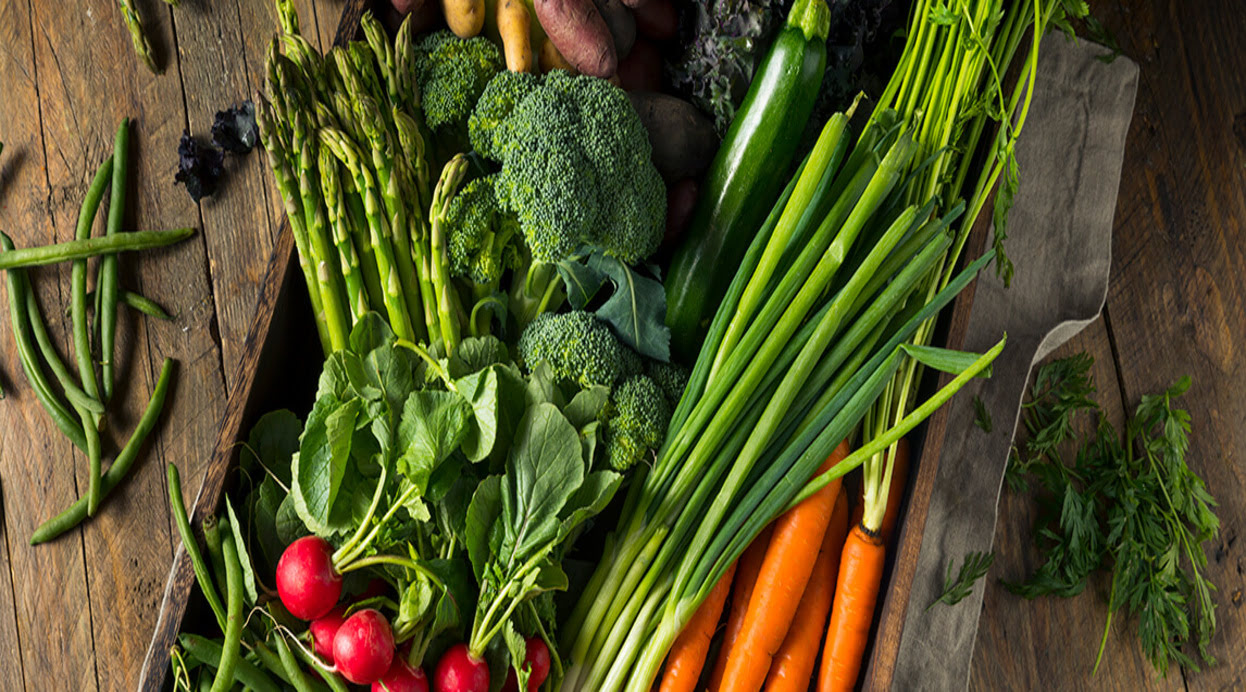Home>Gardening News and Trends>Latest News>How Can Pesticides Affect Birds
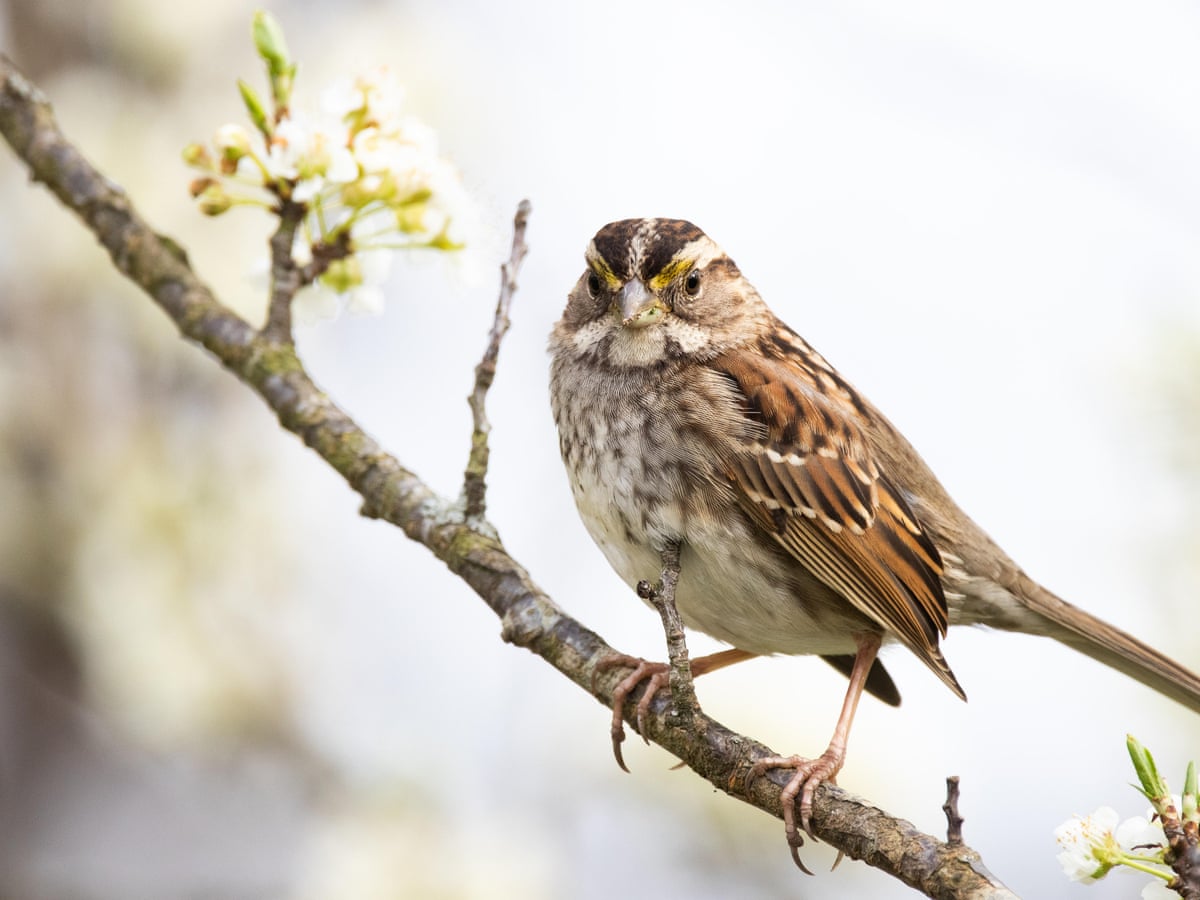

Latest News
How Can Pesticides Affect Birds
Published: November 24, 2023
Discover the latest news on how pesticides can have a detrimental impact on bird populations. Learn about the potential risks and find out what steps can be taken to protect these vulnerable species.
(Many of the links in this article redirect to a specific reviewed product. Your purchase of these products through affiliate links helps to generate commission for Chicagolandgardening.com, at no extra cost. Learn more)
Table of Contents
- Introduction
- Effects of Pesticides on Birds
- Direct Effects
- Indirect Effects
- Habitat Destruction
- Decreased Prey Availability
- Nest Failure and Reproductive Impacts
- Long-term Population Declines
- Impacts on Migratory Birds
- Strategies for Reducing Pesticide Impacts on Birds
- Integrated Pest Management (IPM)
- Use of Less Toxic Pesticides
- Buffer Zones and Setbacks
- Encouraging Natural Predators
- Conclusion
Introduction
Pesticides are chemicals that are widely used in agriculture, gardening, and landscaping to control or eliminate pests such as insects, weeds, and diseases. While pesticides have played a crucial role in increasing crop yields and preventing the spread of harmful pests, their use can have unintended consequences on the environment and wildlife.
Birds, with their diverse habitats and ecological roles, are particularly vulnerable to the effects of pesticides. Pesticides can directly and indirectly impact birds, affecting their behavior, reproduction, and overall population dynamics.
In this article, we will explore the various ways in which pesticides can affect birds and discuss strategies to mitigate these impacts.
Effects of Pesticides on Birds
Direct Effects:
Pesticides can directly harm birds when they come into contact with them. Certain pesticides, such as organophosphates and carbamates, are acutely toxic to birds and can cause immediate mortality. Birds may ingest the pesticides by consuming contaminated food or water, or by preening their feathers after coming into contact with pesticide-treated surfaces.
Indirect Effects:
In addition to direct toxicity, pesticides can also have indirect effects on birds through changes in their habitat and food availability.
Habitat Destruction:
Pesticides used in agriculture, such as herbicides and fungicides, can degrade or destroy the natural habitats that birds rely on for nesting, foraging, and shelter. These chemicals can kill or suppress the growth of plants, reducing the availability of suitable habitat for birds. Moreover, pesticide applications may result in the loss of vegetation structure, leaving birds vulnerable to predation or exposure to harsh weather conditions.
Decreased Prey Availability:
Pesticides can also indirectly impact birds by affecting their food sources. Insecticide use, for example, can kill beneficial insects that birds rely on for food. This reduction in prey availability can lead to nutritional stress and increased competition among bird populations.
Nest Failure and Reproductive Impacts:
Some pesticides, such as certain insecticides and rodenticides, can interfere with bird reproduction. When birds consume contaminated insects, seeds, or prey, they may transfer the pesticides to their eggs or nestlings. Exposure to these chemicals can result in impaired eggshell formation, reduced hatching success, and developmental abnormalities in chicks.
Long-term Population Declines:
The cumulative impacts of direct and indirect effects of pesticides on birds can lead to long-term population declines. Certain bird species, such as raptors and wetland birds, may be particularly susceptible to the bioaccumulation of pesticides in their bodies, as they are higher up in the food chain and can accumulate higher concentrations of toxins over time.
Effects of Pesticides on Birds
Pesticides, although designed to target specific pests, can have varying impacts on birds and their ecosystems. These effects can be both direct and indirect, with wide-ranging implications for bird populations and their habitats.
Direct Effects:
Some pesticides pose immediate threats to birds when they come into direct contact with them. Highly toxic pesticides, such as organophosphates and carbamates, can cause acute poisoning in birds. This could occur when birds feed on crops that have been recently sprayed with these chemicals or when they ingest contaminated insects, seeds, or water. The poisonous effects may range from reproductive issues to organ failure and death.
Indirect Effects:
While the direct effects of pesticides can be concerning, the indirect effects are equally significant. These effects often occur through changes in the birds’ environment and food sources, ultimately affecting their behavior, reproduction, and overall population dynamics.
Habitat Destruction:
Pesticides, particularly herbicides, are commonly used in agriculture to control weeds. However, these herbicides can also kill or suppress the growth of native plants that provide essential habitats for birds. As the vegetation declines, birds lose nesting sites, suitable foraging areas, and protective cover. This habitat destruction can result in reduced breeding success and increased vulnerability to predation.
Decreased Prey Availability:
Insecticide use can have a significant impact on the bird’s food sources. These pesticides target pests like insects, which are a crucial part of many bird species’ diets. However, when these insects are eliminated by pesticides, birds lose a vital food source. This can lead to malnutrition, weakened immune systems, and reduced reproductive success. Furthermore, the decline in insect populations can disrupt the entire ecosystem, affecting other organisms that rely on insects for their survival.
Nest Failure and Reproductive Impacts:
Some pesticides, including certain insecticides and rodenticides, can interfere with bird reproduction. When birds consume contaminated food or prey, they can pass on the pesticides to their eggs or nestlings. This can result in reproductive issues such as thinning eggshells, decreased hatching success, and impaired chick development. These impacts can have long-lasting effects on bird populations, potentially leading to population declines.
Long-term Population Declines:
The cumulative effects of direct and indirect pesticide impacts can gradually decrease bird populations over time. Pesticides can accumulate in the environment and be stored in the bodies of birds. This accumulation can lead to chronic sublethal effects, compromising the overall health of birds and making them more susceptible to diseases, predation, and changing environmental conditions. Species higher up in the food chain, such as raptors and waterbirds, are particularly vulnerable to the bioaccumulation of pesticides due to their feeding habits.
Understanding the effects of pesticides on birds is crucial for developing effective strategies to mitigate these impacts. In the following sections, we will discuss various approaches to reducing pesticide impacts on bird populations.
Direct Effects
The direct effects of pesticides on birds occur when they come into direct contact with these chemicals. Certain pesticides, such as organophosphates and carbamates, are highly toxic to birds and can cause immediate harm and even death upon exposure.
When birds ingest or come into contact with pesticide-treated surfaces, they can suffer from acute toxicity. This can happen through various pathways, including consuming contaminated food or water, or preening their feathers after landing on pesticide-treated surfaces.
The toxicity of pesticides to birds can depend on several factors, such as the chemical’s concentration, the duration of exposure, and the bird species’ sensitivity. Birds of prey, waterbirds, and migratory species are particularly vulnerable to pesticide toxicity due to their feeding habits or because they come into contact with contaminated environments during their migration.
Once a bird is exposed to a toxic pesticide, it can experience a range of adverse effects. These effects can include neurological disorders, respiratory distress, organ failure, and even death. Birds may exhibit symptoms such as loss of coordination, tremors, reduced feeding and grooming behaviors, and general weakness.
One of the concerning aspects of direct pesticide toxicity in birds is its potential to disrupt reproductive success. Pesticides can interfere with the production of eggs, affecting their quality and viability. They can also inhibit proper embryo development, leading to low hatching success or developmental abnormalities in chicks.
It is important to note that not all pesticides have the same level of direct toxicity to birds. Some pesticides are designed to be specific to certain pests and have lower toxicity to non-target organisms. However, even pesticides labeled as “safe” can have unintended detrimental effects on bird populations when used improperly or when birds are exposed to them in high concentrations.
To mitigate the direct effects of pesticides on birds, it is crucial to implement responsible pesticide use practices. This includes following label instructions carefully, using pesticides only as a last resort, and considering alternative pest management strategies that minimize harm to birds and other wildlife. Integrated Pest Management (IPM) techniques can be particularly effective in reducing reliance on pesticides and promoting sustainable pest control practices.
By being aware of the direct effects that pesticides can have on birds and taking proactive measures to minimize their impact, we can help protect bird populations and promote the preservation of healthy and diverse ecosystems.
Indirect Effects
In addition to the direct effects, pesticides can have significant indirect impacts on bird populations through changes in their environment and food sources. These indirect effects can have far-reaching consequences for the behavior, reproduction, and overall resilience of bird populations.
Habitat Destruction:
One of the indirect effects of pesticide use on birds is the destruction or alteration of their habitats. Herbicides, commonly used in agriculture to control weeds, can also harm or eliminate the native plants that provide essential food sources, nesting sites, and shelter for birds. As these plants decline, birds may face difficulties in finding suitable breeding sites, foraging grounds, and protective cover. This can lead to reduced reproductive success and increased vulnerability to predation.
Decreased Prey Availability:
Pesticides, particularly insecticides, are intended to target pests like insects. However, they can also inadvertently harm beneficial insects that birds rely on for food. When these insects are eliminated by pesticides, bird populations can experience a decline in their prey availability. This reduction in food sources can lead to malnutrition, weakened immune systems, and reduced reproductive success among bird populations. Furthermore, the decline in insect populations can disrupt the intricate balance of ecosystems, affecting other species that depend on insects for their survival.
Nest Failure and Reproductive Impacts:
Some pesticides, including certain insecticides and rodenticides, can have detrimental impacts on bird reproduction. Birds can be indirectly exposed to these pesticides when they consume contaminated insects, seeds, or prey. The transfer of these pesticides to their eggs or nestlings can result in reproductive issues such as thinning eggshells, reduced hatching success, and impaired chick development. These impacts can ultimately affect the long-term viability and sustainability of bird populations.
Long-term Population Declines:
When considering the cumulative effects of both direct and indirect impacts of pesticides on birds, it becomes evident that prolonged exposure can lead to long-term population declines. Pesticides, especially those that persist in the environment, can accumulate in bird bodies over time. This bioaccumulation can weaken birds’ immune systems, making them more susceptible to diseases and other environmental stressors. Additionally, some bird species, particularly those high up in the food chain, such as raptors and waterbirds, may accumulate high concentrations of pesticides due to their feeding habits. This accumulation can have devastating consequences for these species and can lead to reduced populations and ecological imbalances.
Understanding and addressing the indirect effects of pesticides on birds is crucial for their conservation and the health of ecosystems as a whole. By adopting sustainable and responsible agricultural practices, promoting habitat restoration, and implementing integrated pest management strategies that reduce reliance on pesticides, we can help mitigate the indirect impacts and ensure the long-term well-being of bird populations and their habitats.
Habitat Destruction
Habitat destruction is one of the significant indirect effects of pesticide use on bird populations. Pesticides, particularly herbicides, are commonly used in agriculture to control weeds and enhance crop productivity. However, these chemicals can have unintended consequences on the habitats that birds rely on for nesting, foraging, and seeking shelter.
Herbicides are designed to kill or suppress the growth of undesirable plants, including weeds. While they effectively remove these unwanted plants, they can also harm or destroy native vegetation that provides essential resources for birds. As native plants decline, birds may face challenges in finding suitable nesting sites, foraging grounds, and protective cover.
The destruction or alteration of habitat can have significant implications for bird populations. When birds lose their natural habitats, they may struggle to find suitable locations to build their nests and raise their young. The loss of vegetation structure and diversity can leave birds exposed and vulnerable to predation or harsh weather conditions.
Furthermore, the reduction in plant diversity caused by habitat destruction can negatively impact the availability of food resources for birds. Different bird species rely on specific plants for food, such as fruits, nectar, or seeds. When pesticide applications lead to the destruction or suppression of these plants, it can reduce the overall availability of food sources, leading to nutritional stress and increased competition among bird populations.
Some bird species have specific habitat requirements and are more susceptible to habitat destruction. For example, cavity-nesting birds, like woodpeckers and certain songbirds, rely on trees with suitable cavities for nesting. When these trees are removed or damaged by pesticides, these bird species can face significant challenges in finding suitable nesting sites, which can have long-term impacts on their reproduction and population dynamics.
Protecting and restoring bird habitats is essential for ensuring the long-term survival of bird populations. Efforts to conserve and restore native vegetation, create wildlife-friendly landscapes, and establish protected areas can help mitigate the impacts of habitat destruction caused by pesticide use.
Alternative agricultural practices that prioritize ecosystem health and biodiversity can also play a crucial role in reducing habitat destruction due to pesticides. Practices such as agroforestry, crop rotation, and cover cropping can promote the cultivation of diverse plant species, creating healthy habitats for birds and other wildlife.
Overall, it is crucial to recognize the indirect impact of pesticide use on habitat destruction for birds and take proactive steps to protect and restore their habitats. By implementing sustainable land management practices and promoting conservation initiatives, we can help safeguard bird populations and ensure the preservation of our natural ecosystems.
Decreased Prey Availability
Pesticides, particularly insecticides, are commonly used to control pests and protect crops. While their primary purpose is to target specific insects, these chemicals can unintentionally impact bird populations by reducing the availability of their prey.
Many bird species rely on insects as a primary food source, especially during the breeding season when they require a high-energy diet to feed their young. Insectivorous birds, such as flycatchers, swallows, and warblers, depend on a steady supply of insects to meet their nutritional needs.
When insecticides are used to eliminate pests, they can inadvertently result in the unintended decimation of beneficial insects. These beneficial insects are an important part of bird diets as they provide a rich source of protein and nutrients.
The decline in insect populations due to insecticide use can have significant consequences for bird populations. Birds may experience malnutrition, weakened immune systems, and reduced reproductive success if they cannot adequately access the necessary food resources.
Additionally, the reduction in insect prey availability can lead to increased competition among bird populations. As the number of available insects declines, birds may have to compete more intensely for limited food resources. This competition can have negative effects on their health and overall population dynamics.
The decline in insect populations caused by insecticides also has broader ecological implications. Insects, as a vital part of the food chain, play multiple roles in ecosystems, such as pollination and nutrient cycling. When their populations decrease, it can disrupt the delicate balance of the ecosystem, affecting other organisms that depend on insects for their survival.
To mitigate the decreased prey availability for birds, it is important to adopt pesticide usage practices that minimize harm to beneficial insects. Integrated Pest Management (IPM) techniques can be effective in pest control while minimizing the impact on non-target organisms, including insects.
Furthermore, promoting habitat diversity and providing suitable habitats for beneficial insects can help ensure a stable and abundant insect population for birds to feed on. Planting native flowering plants, creating insect-attracting landscapes, and preserving natural habitats can foster the presence of beneficial insects and support healthy bird populations.
By recognizing and addressing the impacts of decreased prey availability due to pesticide use, we can work towards a more sustainable approach to pest management and protect the balance of ecosystems where both birds and insects play critical roles.
Nest Failure and Reproductive Impacts
Pesticides, specifically certain insecticides and rodenticides, can have detrimental impacts on the reproductive success of bird populations. These pesticides can indirectly affect bird reproduction when birds consume contaminated food or prey.
When birds ingest insects, seeds, or small mammals that have been exposed to pesticides, they can transfer these chemicals to their eggs or nestlings. This transfer of pesticides can have severe consequences for the developing embryos and chicks.
One of the significant impacts of pesticide exposure is the thinning of eggshells. Some pesticides, such as certain organochlorines, can disrupt the formation of calcium in the eggshells. As a result, the shells become thinner and weaker, making them more susceptible to breakage during incubation.
Additionally, exposure to pesticides can lead to reduced hatching success. Pesticides can impair embryonic development, leading to developmental abnormalities and increased mortality rates within the eggs. As a result, fewer eggs will successfully hatch, which can significantly impact the population size and recovery of bird species.
The reproductive impacts of pesticides extend beyond hatching success. The chemicals can also affect the growth and development of nestlings. Nestlings that are fed pesticide-contaminated prey often face challenges in reaching their full potential. They may exhibit reduced growth rates, impaired motor skills, and compromised immune systems, leading to decreased survivorship.
Furthermore, pesticides can disrupt hormonal balances in birds, affecting their overall reproductive behaviors. Changes in hormone levels can result in altered mating behaviors, decreased parental care, and reduced breeding success.
The long-term impacts of nest failure and reproductive issues can be detrimental to bird populations. If a significant portion of eggs fail to hatch or nestlings do not survive to maturity, it can lead to declines in population size and genetic diversity.
Thus, minimizing pesticide exposure and its impacts on bird reproduction is crucial. Implementing integrated pest management (IPM) practices that prioritize the use of non-toxic or less toxic alternatives can significantly reduce the risk to bird populations.
Conserving and restoring habitats that provide suitable nesting sites and a diverse range of food sources can also support optimal breeding conditions for birds. Preserving natural habitats, protecting important breeding grounds, and promoting biodiversity can enhance the resilience of bird populations and increase their chances of successful reproduction.
By understanding and addressing the nest failure and reproductive impacts of pesticides, we can contribute to the conservation and sustainable management of bird populations.
Long-term Population Declines
Pesticides can have long-term impacts on bird populations, potentially leading to declines in their numbers over time. The cumulative effects of both direct and indirect pesticide impacts can gradually erode the health and viability of bird populations, affecting their long-term sustainability.
One of the significant factors contributing to long-term population declines is the bioaccumulation of pesticides in the bodies of birds. Some pesticides persist in the environment and can accumulate in the tissues of organisms over time. As birds consume contaminated prey or come into contact with pesticide-treated surfaces, their bodies can accumulate these toxic chemicals.
Species higher up in the food chain, such as raptors and waterbirds, are particularly vulnerable to the bioaccumulation of pesticides. These birds consume prey that has already absorbed pesticides or feed on organisms that have accumulated pesticides in their bodies. Over time, the accumulated toxins can lead to a range of health issues, including impaired immune systems, reproductive abnormalities, and developmental disorders.
Long-term population declines can also occur as a result of sublethal effects on bird behavior, physiology, and reproduction. Exposure to pesticides can disrupt migratory patterns, affect foraging behavior, and impact breeding success. Birds that are chronically exposed to low levels of pesticides may experience reduced fertility, decreased fitness, and compromised ability to adapt to changing environmental conditions.
Additionally, the loss and degradation of habitat due to pesticide use can further exacerbate long-term population declines. Habitat destruction reduces the availability of suitable nesting sites, foraging areas, and protective cover for birds. This loss of habitat can limit their ability to successfully reproduce, find adequate food resources, and protect themselves from predators.
The long-term impacts of pesticide use on bird populations can have cascading effects on ecosystems as a whole. Birds play crucial roles in pollination, seed dispersal, and pest control, contributing to the overall health and balance of ecosystems. When bird populations decline, it can disrupt these ecological processes and lead to imbalances within the ecosystem.
To address long-term population declines, it is essential to adopt sustainable pest management strategies that minimize the use of pesticides. Integrated Pest Management (IPM) approaches, which focus on non-chemical alternatives and the targeted use of pesticides when necessary, can help reduce overall pesticide use and its impacts on bird populations.
Conservation efforts that prioritize the preservation and restoration of habitats are also vital. Protecting important breeding sites, preserving natural habitats, and promoting habitat connectivity can support the recovery and resilience of bird populations.
By recognizing and mitigating the long-term population declines caused by pesticide use, we can strive towards the preservation and sustainability of bird populations and the ecosystems they inhabit.
Impacts on Migratory Birds
Migratory birds are particularly vulnerable to the impacts of pesticides due to their extensive travels and reliance on multiple habitats throughout their life cycle. The use of pesticides along their migratory routes and in their breeding and wintering grounds can have profound consequences on their survival and reproductive success.
Migratory birds rely on various habitats along their journeys, including breeding grounds, stopover sites, and wintering grounds. These habitats provide essential resources such as food, shelter, and safe nesting sites. However, the use of pesticides in these areas can disrupt these critical resources, affecting migratory birds at different stages of their life cycle.
When pesticides are used in breeding grounds, they can directly impact the reproductive success of migratory birds. Birds that consume pesticide-contaminated prey or come into contact with pesticide-treated vegetation may experience decreased fertility, impaired egg development, and reduced hatching success. These impacts can have long-lasting effects on the productivity and population dynamics of migratory bird species.
As migratory birds travel to their wintering grounds, they may encounter pesticide-contaminated habitats along their migratory routes. These areas, which provide crucial stopover sites for rest and refueling, can become hazardous if contaminated with pesticides. Birds that feed on insects, fruits, or other food sources containing pesticides may suffer from acute toxic effects or long-term sublethal impacts.
The impacts of pesticides on migratory birds are not limited to their breeding and wintering grounds. Pesticide use in agricultural areas can have implications for migratory birds that forage on crops or stopover in nearby habitats. Birds may unintentionally ingest pesticides when they consume contaminated crops or prey on insects exposed to pesticides. These exposures can compromise their health, the success of their migration, and their ability to sustain their journeys.
Migratory birds, often covering thousands of miles during their migrations, rely on an intricate network of interconnected habitats. The loss or degradation of these habitats due to pesticide use can hinder their ability to find suitable stopover sites and food sources. It can also disrupt the timing and success of their migrations, impacting their ability to complete their journeys and negatively affecting their overall population numbers.
Protecting the habitats and stopover sites that migratory birds rely on is essential for their conservation. This involves implementing pesticide management practices that prioritize the protection of these vulnerable species. Integrated Pest Management (IPM) strategies, along with the targeted use of pesticides and alternative pest control methods, can help reduce the risks posed to migratory birds.
International cooperation and conservation efforts are also critical for the protection of migratory birds. Collaborative initiatives, such as the creation of protected areas and the enforcement of regulations on pesticide use, can help safeguard the habitats used by migratory bird populations throughout their vast range.
By reducing pesticide exposure and preserving essential habitats along migratory routes, we can contribute to the protection and well-being of migratory bird populations and ensure their continued awe-inspiring journeys.
Strategies for Reducing Pesticide Impacts on Birds
Reducing the impacts of pesticides on bird populations requires a comprehensive and multifaceted approach that incorporates sustainable pest management practices and habitat conservation. By implementing the following strategies, we can help minimize pesticide impacts and promote healthier bird populations:
Integrated Pest Management (IPM): Implementing IPM practices is crucial for reducing reliance on pesticides. IPM approaches prioritize the use of non-chemical methods to manage pests, such as crop rotation, biological control, and cultural practices. By incorporating these techniques, farmers and gardeners can target pests specifically and minimize the need for chemical interventions, thereby reducing the risk to bird populations.
Use of Less Toxic Pesticides: When pesticide use is necessary, opting for less toxic alternatives can help minimize the impacts on birds. Using pesticides with lower toxicity to non-target organisms, such as those labeled as “reduced-risk” or “organic,” can be an effective strategy. Choosing products with minimal residual effects and selecting formulations that minimize drift and runoff can also reduce exposure to birds and other wildlife.
Buffer Zones and Setbacks: Establishing buffer zones and setbacks can help reduce pesticide exposure for birds and other non-target organisms. Creating vegetated strips or areas of natural vegetation around fields or water sources can act as protective barriers, reducing the drift of pesticides into adjacent habitats. This can provide valuable habitats and food sources for birds and enhance overall biodiversity.
Encouraging Natural Predators: Promoting the presence of natural predators, such as birds of prey or beneficial insects, can help control pest populations naturally. By providing suitable habitats and nesting sites for these predators, farmers and landowners can harness their natural pest control abilities and minimize the reliance on chemical pesticides. This can create a healthier balance in agricultural ecosystems and reduce the impacts on bird populations.
Conservation of Habitat: Protecting and restoring habitats is critical for supporting healthy bird populations. Preserving natural habitats, creating wildlife corridors, and establishing protected areas can provide safe nesting sites, suitable foraging grounds, and protective cover for birds. Conservation efforts that focus on habitat restoration, rewilding, and the planting of native vegetation can enhance the resilience of bird communities and promote biodiversity.
Pesticide Education and Training: Educating farmers, gardeners, and the general public about the impacts of pesticides on bird populations is essential. Providing training on the proper use and handling of pesticides as well as the importance of alternative pest control methods can help raise awareness and encourage responsible pesticide use practices. By promoting informed decision-making, we can empower individuals to make choices that minimize harm to birds and their habitats.
Research and Monitoring: Continued research into the impacts of pesticides on bird populations is crucial for developing effective mitigation strategies. Monitoring bird populations, conducting field studies, and assessing the long-term effects of pesticide exposure can help identify hotspots and trends, enabling targeted conservation efforts and policy interventions.
By implementing these strategies and prioritizing the well-being of bird populations, we can reduce the impacts of pesticides on birds and foster healthier and more resilient ecosystems.
Integrated Pest Management (IPM)
Integrated Pest Management (IPM) is an approach to pest control that aims to minimize the impacts of pesticides on the environment, including bird populations. It involves a comprehensive and holistic strategy that combines multiple pest control methods to manage pests effectively while minimizing reliance on chemical interventions.
IPM focuses on preventing pest problems before they occur, utilizing biological, cultural, mechanical, and chemical control methods in an integrated manner. By employing a combination of strategies, farmers, gardeners, and land managers can effectively manage pests while reducing the risks to non-target organisms, including birds.
One of the fundamental principles of IPM is proper pest identification and monitoring. By monitoring pest populations, the presence of natural enemies, and the level of damage, practitioners can make informed decisions about the need for intervention and the appropriate control methods to employ. Targeted interventions can help reduce pesticide usage and minimize negative impacts on bird populations.
Biological controls are integral to IPM and involve promoting the use of natural enemies to manage pest populations. Birds, such as certain species of raptors and insectivorous birds, play a vital role in controlling pest populations in agricultural and natural ecosystems.
Conserving and enhancing the habitats of natural predators can help foster a healthy balance in ecosystems. Providing suitable nesting sites, food sources, and vegetation structures can encourage the presence of birds that prey on pests, thus reducing the need for chemical pesticides.
Cultural practices, such as crop rotation, planting resistant crop varieties, and practicing good sanitation, are vital components of IPM. These practices can disrupt pest life cycles, reduce pest populations, and mitigate the need for chemical interventions. By implementing these methods, farmers can create an environment that is less conducive to pest outbreaks and minimize the impacts on bird populations.
Mechanical and physical controls are also integral to IPM. These methods involve the use of physical barriers, traps, and other devices to physically prevent or remove pests. By employing these non-chemical methods, farmers can minimize the need for pesticides, ensuring a healthier environment for birds and other wildlife.
Lastly, chemical controls are utilized in IPM when necessary, but they are applied judiciously and strategically. When selecting pesticides, preference is given to those with low toxicity to birds and minimal impacts on non-target organisms. Pesticides are used as a targeted treatment for specific pests and are applied at the right time and in the right quantities, following label instructions and taking into consideration local regulations and guidelines.
By adopting IPM practices, farmers and land managers can effectively manage pests while minimizing the negative impacts on bird populations. IPM promotes a balanced and sustainable approach to pest control, ensuring a healthier environment for both humans and wildlife.
Use of Less Toxic Pesticides
Minimizing the impacts of pesticides on bird populations involves prioritizing the use of less toxic alternatives. Choosing and employing less toxic pesticides can help reduce the risks to non-target organisms, including birds, while still effectively managing pest populations.
When selecting pesticides, it is crucial to consider their toxicity to birds and their potential to accumulate in the environment. Opting for pesticides with lower toxicity can significantly mitigate the adverse effects on bird populations.
Several categories of pesticides are considered to have lower toxicity profiles, including those labeled as “reduced-risk” or “organic.” These types of pesticides often have shorter half-lives and break down more rapidly in the environment, reducing the chances of prolonged exposure to birds and other organisms.
It’s important to carefully read and follow label instructions when using any pesticide, including those labeled as less toxic. This ensures proper application, dosage, and timing. Following label instructions will help minimize the unintended exposure of birds to pesticides and reduce potential harm.
In addition to selecting less toxic pesticides, using formulations that minimize drift and runoff can further reduce their effects on bird populations. Applying pesticides during calm weather conditions and avoiding spraying near water bodies or areas frequented by birds can help prevent unintended exposure.
Integrated Pest Management (IPM) practices prioritize the use of non-chemical methods whenever possible. By combining multiple pest control strategies, such as biological control and cultural practices, the reliance on chemical pesticides can be significantly diminished.
Non-chemical pest control methods, such as the use of traps, barriers, and mechanical removal, can effectively manage pests without the need for toxic chemicals. Implementing these strategies alongside the targeted application of less toxic pesticides can help maintain pest control while minimizing the impacts on bird populations.
Regular re-evaluation of pest control practices, including the use of less toxic pesticides, can contribute to ongoing improvements in pesticide management. Staying informed about new research and developments in pest control methods can enable farmers, gardeners, and land managers to make informed decisions and choose the most suitable and environmentally friendly options.
By reducing the use of highly toxic pesticides and opting for less toxic alternatives, we can protect the health and wellbeing of bird populations. Prioritizing the use of less harmful pesticides promotes a more sustainable and bird-friendly approach to pest management.
Buffer Zones and Setbacks
Buffer zones and setbacks are essential strategies for reducing pesticide impacts on bird populations by creating protective barriers between pesticide-treated areas and natural habitats. These designated areas of vegetation help minimize the drift and runoff of pesticides, reducing their negative effects on birds and other non-target organisms.
Buffer zones are vegetated strips or areas of natural vegetation strategically placed around fields, water bodies, or sensitive habitats. These zones act as physical barriers, helping to intercept and absorb pesticide residues before they reach adjacent areas. Buffer zones can mitigate the exposure of birds to pesticides by reducing the likelihood of direct contact or accidental ingestion.
The width and composition of buffer zones can vary depending on the specific pesticide being used, the characteristics of the landscape, and the sensitivity of the nearby habitats. In general, wider buffer zones are more effective in minimizing pesticide drift and runoff. They provide a greater buffer between pesticide-treated areas and natural habitats, allowing more time and space for pesticides to degrade or be absorbed by vegetation before reaching non-target areas.
Setbacks are similar to buffer zones but involve creating distance between pesticide application areas and sensitive sites, such as water bodies, wetlands, or protected habitats. Setbacks can help prevent or minimize pesticide runoff into water sources and provide additional protection to birds and aquatic organisms.
Both buffer zones and setbacks play a crucial role in protecting bird populations, as they reduce the direct exposure of birds to pesticides and their indirect exposure through contaminated food and water sources.
To optimize the effectiveness of buffer zones and setbacks, it is important to consider several factors:
- The width of the buffer zone or setback should be determined based on the pesticide’s properties, such as volatility and mobility, and the local ecological context.
- Vegetation within the buffer zone should be diverse and include native plant species that can absorb and degrade pesticides more effectively.
- The buffer zone should be well-maintained to ensure its effectiveness in filtering pesticides and providing suitable habitat for birds.
- Appropriate signage and communication should be in place to inform individuals and workers about the buffer zones and setbacks to ensure compliance.
- Collaboration and coordination with neighboring landowners or stakeholders are crucial to establishing effective buffer zones and setbacks, as pesticide drift and runoff can travel across property boundaries.
Implementing buffer zones and setbacks requires awareness, education, and collaboration among farmers, land managers, and policymakers. By incorporating these protective measures, we can create safer environments for birds, minimize pesticide impacts, and promote coexistence between agriculture and wildlife.
Encouraging Natural Predators
Encouraging the presence of natural predators is an effective strategy for managing pests in a bird-friendly manner. By promoting the populations of natural predators, such as birds of prey and beneficial insects, we can reduce the reliance on chemical pesticides and foster a more natural and sustainable pest control system.
Natural predators play a vital role in keeping pest populations in check. Birds of prey, such as owls, hawks, and kestrels, feed on rodents, small mammals, and insects that can cause damage to crops. Encouraging the presence of these birds of prey can help minimize the need for chemical rodenticides and insecticides.
In agricultural settings, creating suitable habitats and providing nesting structures for birds of prey can attract these natural predators to the area. Nest boxes, perching posts, and artificial roosting sites can offer essential resources for these birds and encourage them to establish territories and breed in the vicinity of crop fields.
Beneficial insects, such as ladybugs, lacewings, and parasitic wasps, also play a crucial role in regulating pest populations. These insects feed on aphids, caterpillars, and other pests that can damage crops. By promoting the presence of beneficial insects, farmers and gardeners can reduce dependence on chemical insecticides.
To encourage beneficial insects, it is essential to provide suitable habitats and food sources. Planting a diverse range of flowering plants, particularly those that attract pollinators, can help support populations of beneficial insects. These insects will not only assist in controlling pests but also contribute to pollination, benefiting the overall health and productivity of the ecosystem.
Conserving natural habitats and promoting biodiversity is another key aspect of encouraging natural predators. Maintaining forested areas, wetlands, and grasslands provides essential habitats for birds of prey and beneficial insects. These diverse ecosystems offer an abundance of food sources and shelter for natural predators, allowing them to thrive and contribute to pest control efforts.
Implementing sustainable land management practices, such as reduced pesticide use and minimizing habitat destruction, is crucial for supporting natural predators. Excessive pesticide use can harm natural predators directly or indirectly by depleting their prey sources. By reducing pesticide applications, we create an environment where natural predators can fulfill their role in pest regulation.
Education and awareness are essential components of encouraging the presence of natural predators. Farmers, gardeners, and land managers should be educated about the importance of natural predators in pest control and the negative impacts of excessive pesticide use on their populations. Understanding the ecological benefits of natural pest control can encourage individuals to implement practices that support natural predator populations.
By promoting the presence of natural predators, we can create a more balanced and sustainable approach to pest control that is beneficial for both bird populations and agricultural ecosystems. Incorporating these natural pest control methods alongside other strategies, such as integrated pest management (IPM), can help minimize the reliance on chemical pesticides and promote harmony between agriculture and wildlife.
Conclusion
The impacts of pesticides on bird populations are a significant concern in today’s agricultural and ecological landscapes. Direct and indirect exposure to pesticides can harm birds, affecting their behavior, reproduction, and overall population dynamics. However, by implementing effective strategies, we can reduce the negative impacts and promote healthier bird populations.
Integrated Pest Management (IPM) practices provide a comprehensive approach to pest control, prioritizing non-chemical methods and targeted pesticide use when necessary. By combining biological, cultural, mechanical, and chemical controls, we can effectively manage pests while minimizing risks to birds and other non-target organisms.
Furthermore, opting for less toxic pesticides and formulations can significantly mitigate the adverse effects on bird populations. Choosing pesticides with lower toxicity to birds and utilizing formulations that minimize drift and runoff can help protect bird habitats and food sources.
Creating buffer zones and setbacks can act as protective barriers, reducing pesticide drift and contamination of natural habitats. By establishing vegetated strips or areas of native vegetation, we can minimize direct exposure and provide additional habitat for birds.
Encouraging the presence of natural predators, such as birds of prey and beneficial insects, can contribute to sustainable pest control. By supporting natural pest control systems, we can decrease reliance on chemical pesticides while promoting biodiversity and ecological balance.
Conserving and restoring habitats, as well as promoting biodiversity, play integral roles in mitigating pesticide impacts on bird populations. Protecting essential nesting areas, providing suitable foraging grounds, and preserving natural ecosystems are crucial for the long-term survival of bird species.
Education and awareness are essential components of reducing pesticide impacts on birds. By promoting responsible pesticide use practices, disseminating information about the benefits of natural pest control, and raising awareness about the importance of bird conservation, we can create a collective effort towards protecting bird populations.
Overall, minimizing the impacts of pesticides on birds requires a combination of management approaches that prioritize sustainable practices, establish protective measures, and support the preservation of habitats and biodiversity. By implementing these strategies, we can promote the coexistence of agriculture, pest control, and thriving bird populations.
